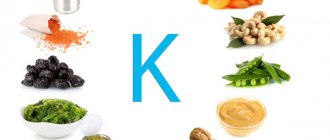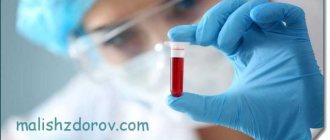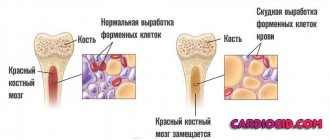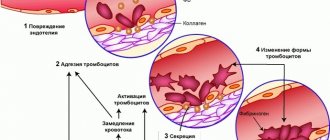Norm and deviations
In order to determine blood clotting indicators in a particular person, it is necessary to conduct a laboratory analysis of biological material. In a normal state, the density of blood is concentrated at 1048-1066 units, and the density of the plasma in the composition is also important. Its normal values are 1029 – 1034. Arterial blood is less dense than venous blood.
The viscosity itself depends on the ratio of proteins and red blood cells in the liquid tissue. In cases with deviations, several scenarios are possible - the blood becomes too thick or too thin.
Thrombophilia is a bleeding disorder with excessive plasma density, along with blood cells. The disease is dangerous because it increases the risk of blood clots; a person is susceptible to diseases such as thrombosis or varicose veins. If deviations are not controlled, the risk of strokes and heart attacks increases, and the load on the liver and kidneys increases, causing chronic problems with these organs.
A deviation in which the blood is too thin is called hypocoagulation; it can threaten a person with large blood loss with minimal trauma or damage.
Symptoms
When coagulation deteriorates, platelets, hemoglobin, and red blood cells cannot perform their functions normally. These cells actively stick together.
Symptoms of hypercoagulation:
- Regular fatigue, weakness, drowsiness.
- A feeling of heaviness in the lower extremities, due to which the patient quickly gets tired when walking.
- Periodic headaches.
- The formation of bruises on the skin even with minor bruises.
- Bleeding gums.
- Malfunction of the digestive organs.
- Swelling and pain in hemorrhoids.
- Formation of spider veins on the legs.
Important!!! These manifestations are temporary, as they disappear immediately after the provoking factor is eliminated. Typically, such symptoms are observed in patients suffering from obesity, cancer, autoimmune disorders, and diabetes. People who are addicted to smoking and under stress are susceptible to increased clotting.
Bruises from minor injuries
Causes of increased blood clotting
The composition of human blood always remains unchanged, but the ratio of components constantly fluctuates throughout life. This is influenced by many factors.
What affects blood clotting in adults:
- increased levels of red blood cells and platelets due to disease;
- high hemoglobin levels;
- dehydration or poor fluid absorption;
- insufficient amount of enzymes;
- large blood loss due to open injuries to the epidermis or damage to internal organs;
- frequent consumption of foods containing large amounts of sugar and carbohydrates;
- constant being in a stressful state;
- radiation exposure.
The cause of hypercoagulation is old age, hereditary pathologies, certain medications, as well as diseases that cause the formation of fibrinogen in quantities significantly higher than normal.
Specifically speaking, the reasons for increased blood clotting may include the following abnormalities:
- infectious diseases;
- hepatitis, liver cirrhosis;
- hormonal imbalances;
- atherosclerosis;
- thrombophilia, varicose veins;
- diabetes;
- weakened immune system;
- pancreatitis;
- development of benign or malignant neoplasms;
- genetic pathologies;
- hypoxia, constant surges in blood pressure;
- myeloma;
- hemophilia, von Willebrand disease.
Read also Thrombocytopenia of newborns
The high-risk group consists of people who lead a passive, sedentary lifestyle - bedridden patients, as well as pregnant women, since their body is undergoing serious hormonal changes. All of the above leads to increased blood thickening.
Why is clotting impaired?
Pathological processes can increase platelet formation. The main causes of blood hypercoagulation in women and men are the following factors:
- Viral pathologies.
- Failure of hormonal balance.
- Diseases of the liver and spleen.
- Pregnancy.
- Disruption of the circulatory system due to an inactive lifestyle.
- Hereditary predisposition.
- Dehydration of the body.
- Treatment of pathologies with radiation.
- Metabolic disorders.
- Autoimmune diseases.
- Long-term use of coagulants.
- Chronic diseases.
- Vitamin K deficiency.
High coagulability leads to changes in the composition and thickening of the liquid, which causes excessive formation of blood clots in the vessels, which is dangerous to human life. When such a blood pathology is detected, immediate treatment is required.
Due to the increased formation of blood clots, the lumen of the blood vessels narrows. A small amount of oxygen enters the blood, which contributes to the development of ischemia in humans.
When there is insufficient oxygen concentration, tissues die and organ activity fails. The most dangerous consequence is damage to the brain and myocardium. The blood clot can break off, which can be fatal.
Problems with blood circulation make it difficult for women to conceive a child. If the pathology is neglected, infertility is possible.
Increased clotting rates
Diagnosis of disorders
In order to determine the density and composition, it is necessary to take blood clotting tests. In case of serious deviations, the problem will become obvious immediately, since the blood clots quickly and collecting material is difficult.
In the absence of obvious violations, the laboratory analyzes the plasma and the protein it contains. Determination of blood clotting time is carried out manually - a drop of material is placed under a microscope, and a specialist records changes in the composition using continuous observation and a stopwatch.
Read also: What is thrombocytopenia
Also, when making a diagnosis, anamnesis is important - the doctor must be aware of the diseases the patient has suffered and surgical interventions. Diseases that affect his immediate family or the presence of pregnancy when it comes to a woman are no exception.
The study of hemostasis with diagnosis is impossible without determining the level of platelets and a detailed analysis of other plasma components, such as fibrinogen, alpha, beta, gamma globulins.
Treatment of the disorder
Before prescribing drugs that reduce blood clotting, the patient must undergo a full examination to identify the cause of the disease. Therapy depends not only on the culprit of the disorder, but also on the nature of the pathology.
During treatment, the following drugs are prescribed: anticoagulants, antispasmodics, anti-inflammatory drugs. In advanced situations, they resort to transfusion or surgery to remove blood clots.
If the disorder is hereditary, doctors prescribe high dosages of the antiplatelet drug Aspirin using drugs that reduce blood clotting. The medication is taken for a long time, more than a month.
Important!!! In case of pregnancy, it is not recommended to take the drug, so therapy is determined individually by the gynecologist.
Therapy with a leech is possible. These creatures inject a special enzyme that dissolves blood clots. As a result, the blood thins, which improves clotting.
Treatment of a child or adult with drugs that reduce blood clotting is carried out under the supervision of a specialist. And you need to get tested regularly. Medicines that increase blood clotting may cause internal bleeding. Therefore, you should not self-medicate.
In addition to pills for hypercoagulation, you need to know how to reduce blood clotting using food. The diet includes fresh vegetables, fruits, fish, and seafood. The diet should be balanced. It is also necessary to drink at least 2 liters of water per day, but reduce the consumption of coffee, carbonated drinks and alcohol.
"Aspirin"
Recommended infusions
How to reduce blood clotting using folk remedies? Traditional medicine recommends the following recipes for preparing tinctures:
- From chestnut. 50 g of chestnut (horse) peel is poured into 0.5 liters of vodka and allowed to brew for 14-15 days in a dark place. Take 30 drops per day 30 minutes before meals, diluting with water. The course of treatment is 3 weeks, and then you need to take a break. There are contraindications: low blood pressure, gastritis, menstrual irregularities, problems with constipation. Before use, you should definitely consult with your doctor, because during the treatment there is a risk of internal bleeding.
- From mulberry. Mulberry roots are filled with water and brought to a boil. The course of treatment is 5 days.
- From Galega officinalis. The infusion is sold at the pharmacy, ready for use. You need to take 30 drops 3 times a day, the course of treatment is 1 month, once a year.
- From gingo biloba. Ginko biloba leaves are infused with alcohol. Drink 0.5 tablespoon 3 times a day 30 minutes before meals. The course of treatment is 1 month, and then a break for 7 days.
- From ginger. Ginger root is grated, poured with boiling water, green tea and cinnamon are added to taste. If desired, you can add lemon or honey. You need to drink 0.5 liters of this tincture tea per day.
The methods listed above are very helpful in reducing blood clotting.
Normalization of nutrition
To thin thick blood it is recommended:
- Fatty fish such as mackerel, horse mackerel, sardine, herring, capelin, as well as fish oil.
- Onions and garlic - these vegetables reduce the risk of cancer and blood clots. It is advisable to use them as follows: chop the garlic and let it sit for a while until it wilts. And onions are added to soups, chopped or whole.
- Almost all citrus fruits can thin the blood. Especially lemon.
- Red wine, natural, but you can drink up to 50 ml a day.
- Cocoa.
- Vegetable oils, among them flaxseed and olive are especially useful.
- Bay leaf, it is added mainly to liquid dishes, 2-3 leaves each.
- Seeds and hazelnuts.
- Bitter chocolate.
- Tomato juice.
- Ginger.
- Weak green tea.
- Berries such as raspberries, strawberries, cherries and cherries.
- Cereals with magnesium content: oatmeal, oats, rolled oats.
- Water.
Advice! You need to drink water often, but in small sips, this way the optimal effect is achieved.
In order to thin the blood, it is recommended that pregnant women and other patients review their daily diet. A diet for the problem under consideration involves giving up certain foods. What is not allowed is determined by the attending physician based on the patient’s individual indicators.
Dietary nutrition includes the following conditions:
- Active consumption of liquids. Every day the patient needs to drink up to 1.5–2 liters of liquid. It is recommended to opt for clean, still water. The liquid itself must be consumed throughout the day.
- Reduce your salt intake. It prevents the removal of fluid from the body, which causes the formation of edema.
- There are more products with ascorbic acid. It promotes rapid blood thinning. Ascorbic acid can be found in berries, fruits (grapefruit, lime, lemon), red and orange vegetables.
- Add a variety of spices to your diet. It is recommended to use as a seasoning for dishes:
- turmeric;
- oregano;
- dill;
- ginger;
- thyme.
- Use rapeseed, olive and linseed oils.
During treatment you must avoid:
- milk and dairy products;
- meat products and preservation;
- egg yolk;
- chocolate, coffee and foods high in sugar;
- bakery products.
To supplement the diet, adjustments to daily physical activity towards their reduction are intended. However, you cannot completely abandon them.
Coagulogram data and their norms
An ideal coagulogram should look something like this:
- Thrombin time is 10-17 seconds.
- Prothrombin time - 78-142%:
- Activated partial thromboplastin time (aPTT) - 25-37 seconds.
- Fibrogen - for adults 2-4 g/l, for newborns 1.25-3 g/l.
- Antithrombion III - 83-128%.
- D-dimer - no more than 243 ng/ml, for pregnant women in the last trimester up to 644 ng/ml.
- Plasminogen activity is 80-132%.
- Protein C activity is 70-140%.
- Free protein S - in the male half of the population 74-146%, in the female half of the population 54-123%.
- Lupus anticoagulant - negative.
What leads to an increase in hematocrit
Thick blood can be caused by various pathological processes. Similar factors provoke an increase in hematocrit in men and women. But in the first case, the problem under consideration occurs more often due to the reasons described above.
Dehydration
Dehydration occurs due to:
- insufficient fluid intake into the human body;
- renal pathologies;
- course of diabetes mellitus;
- fever;
- living in a region with high ambient temperatures;
- continuous vomiting caused by severe intoxication or other pathological processes;
- persistent diarrhea resulting from food poisoning;
- chronic pyelonephritis.
Dehydration also threatens a person with diseases that are accompanied by an increase in body temperature. This reaction of the body is designed to normalize the patient’s condition, resulting in increased sweating and frequent urination.
A number of drugs (mostly synthetic drugs) with long-term use have a negative effect on the condition of the blood: its plasma gradually loses its liquid part, which ultimately leads to an increase in hematocrit. Such phenomena can be caused by:
- drugs used to treat pathologies of the adrenal cortex (for example, hydrocortisone);
- contraceptives taken orally;
- diuretics;
- medications intended to restore erectile function.
These tablets can be used only after agreeing on the course of treatment with your doctor and in the dosage prescribed by the specialist.
In case of gastric, intestinal and liver pathologies, some of the metabolic products are insufficiently oxidized and enter the circulatory system in this form. This leads to an increase in the content of formed elements, including glucose, while maintaining the same plasma concentration.
Impaired functioning of the respiratory system causes a decrease in the amount of oxygen entering the body. The lack of this substance provokes the onset of hypoxia and blood oxidation.
The latter circumstance negatively affects the viability of formed elements: they begin to accumulate in the vessels. As a result, against the background of hypoxia, the process of breakdown of blood cells and the release of products that worsen the course of the pathological condition are accelerated.
An increase in the amount of cholesterol in the blood is known as hypercholesterolemia. This process helps to increase the hematocrit. In this case, a change in blood viscosity occurs against the background of the active entry into the plasma of not only cholesterol, but also other elements: triglycerides, lipoproteins.
Infection of the body
Infection of the body with various infections or parasitic life forms leads to activation of the immune system. Its cells penetrate into the circulatory system, where they subsequently die, thereby increasing the plasma concentration.
This process is due to the fact that some leukocytes are constantly located in the submucosal layer of the intestine. This organization allows you to avoid the state of overcrowding of blood vessels. However, in case of helminthic or infectious pathology, leukocytes return to the bloodstream, as a result of which the viscosity of the liquid increases.
Strong experiences lead to an increase in the level of various components in the bloodstream: cholesterol, glucose and other elements. At the same time, to increase hematocrit, it is necessary that a person regularly experiences nervous strain. Episodic stress has little effect on the state of the circulatory system.
At the same time, the regular release of adrenaline into the blood, which occurs against the background of nervous experiences, not only increases the hematocrit, but also negatively affects the functions of the bone marrow.
Other factors
There are quite a few factors that provoke the appearance of thick blood. These also include:
- negative environmental influences, smoking, exposure to carbon dioxide and exhaust gases;
- antiphospholipid syndrome;
- erythremia, in which the level of red blood cells increases;
- leukemia;
- myeloma;
- cirrhosis of the liver;
- hepatitis;
- pancreatitis;
- phlebeurysm;
- thermal burns.
Poor nutrition is another fairly common cause of blood thickening. The appearance of this consequence is explained by the fact that after products have entered the body, the immune system releases many cells to cleanse them of foreign elements. That is, after each meal a person’s blood becomes a little thicker.
In a newborn, blood parameters differ significantly from those in adults and children over the age of one year. They normalize over time. In particular, newborns have high levels of hemoglobin and red blood cells.
These phenomena are due to the fact that the child’s body finds itself in an unfamiliar environment and reacts accordingly. By about a year, all indicators are restored and approach those of adults.
Symptoms of high clotting
An accurate diagnosis can only be made by a doctor based on blood tests, but some symptoms can be noticed without special equipment; they will be obvious to the average person:
- A large number of bruises that appear as a result of minor injuries and minor bruises. This is due to the increased fragility of small vessels.
- The gums begin to bleed.
- The functioning of the gastrointestinal tract organs (for example, intestines, spleen) is disrupted. This happens due to a lack of oxygen and other useful substances.
- Hemorrhoids increase in size and become overly sensitive and painful.
- Venous nodules and asterisks from blood vessels appear on the legs.
Possible complications
Most often, thick blood is diagnosed in older people. This is explained by the fact that over time the human body copes with its functions worse, as a result of which decay products are excreted in a smaller volume. Due to thick blood, the load on the cardiovascular system increases, which ultimately leads to the occurrence of corresponding pathologies.
The risk of developing complications with the problem under consideration directly depends on the reasons that caused it.
It was said above that with thick blood there is a decrease in blood flow. This problem is especially pronounced at the level of small vessels. As a result, fluid stagnation occurs, which leads to:
- reducing the supply of oxygen and nutrients to cells;
- stagnation of under-oxidized products;
- release of radicals.
The described processes contribute to disruption of homeostasis and the occurrence of hypoxia.
In addition, due to the slowing of blood flow, the permeability of the vascular walls increases. This circumstance is one of the main reasons:
- formation of atherosclerotic plaques;
- gluing blood clots together, which becomes a prerequisite for the occurrence of thrombosis.
These processes provoke:
- myocardial infarction;
- brain stroke;
- thromboembolism of the pulmonary artery system;
- fatal outcome.
Reduced blood flow also contributes to the appearance of hypertension (high blood pressure) and frequent bleeding.
The consequences for a child during pregnancy against the background of the development of the pathological process in question will be much more severe than for a woman. Thick blood causes the following negative effects:
- varicose veins affecting the lower extremities;
- hypoxia of a still unformed child;
- thrombosis, strokes, heart attacks;
- disorders in child development;
- suspension of pregnancy progress;
- miscarriage.
If you do not take any measures to thin the thick blood, the likelihood of the child’s death will be extremely high.











